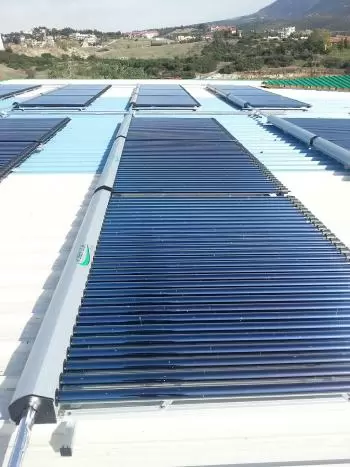
An evacuated tube solar collector is a type of solar thermal collector that improve flat plate collectors. Solar collectors aim to convert solar radiation into thermal energy reducing heat losses.
The vacuum tube solar collector consists of a set of cylindrical tubes. The tubes are made up of a selective absorber on a reflective seat and surrounded by a transparent glass cylinder.
A vacuum has been created between the transparent outer tube and the inner absorber that acts as a diathermic wall. The internal absorber consists of a copper heat pipe that contains a vaporized fluid. This characteristic makes it possible for the heat transfer fluid to reach temperatures of more than 100º.
Evacuated tube solar collectors are frequent in solar water heaters. As a result, solar water heating can be used to obtain domestic hot water (DHW) in order to supply heated water to heating systems, swimming pool heating, etc.
Evacuated tube solar collector working
In solar vacuum tube collectors, the insulating effect is achieved by a vacuum in a glass tube or the space of two concentric glass tubes.
Evacuated tube solar collector absorbs part of the solar radiation which strikes the outer glass tube. The radiation crosses the vacuum space between the outer and inner pipe without energy loss. Finally, solar radiation heats the working fluid inside the inner pipe and vaporizes it.
The heated vapor goes to the condenser, transferring its heat energy to the solar working fluid through the manifold. Consequently, having lost temperature, the vapor condenses and returns to the solar exposed zone.
A pump makes flow the solar working fluid throw the circuit. The fluid enters the manifold at a low temperature to increase its temperature as it passes along the manifold.
For more information, you can look at this website about how an evacuated tube solar collector works.
Advantages of evacuated tube solar collectors
The benefits of vacuum tube collectors versus flat solar collectors are explained below.
-
Evacuated tube solar collectors are cheaper than flat solar collectors. Nowadays, the price has improved due to the growing demand, experience, and new tube manufacturing technologies.
-
Heat and light are harnessed by absorbing the sun's rays from sunrise to sunset. In contrast, flat solar panels are only at peak performance at noon. Thus, they are less efficient and require a larger surface area to produce the same amount of power.
-
It is more durable and reliable because the vacuum protects the collector from corrosion and does not present condensation.
-
The vacuum eliminates conduction and convection energy transfer losses.
-
They are easy to install due to their lightweight and modular structure.
-
The cost of reparation is lower because tubes are replaced one by one in case of breakage.
-
The sun's rays are caught more effectively due to the circular shape of the tubes, especially at sunrise and sunset.
-
The wind can circulate freely between the tubes making these collectors more resistant to gales due to the round shape and the separation between them. In addition, the snow does not accumulate as much as in flat collectors. Moreover, they are cleaner as they get less dust and dirt.
Types of evacuated tube solar collectors
Currently, there are two types of vacuum tube solar collectors. They have pretty different techniques in terms of heat transmission from the vacuum tube to the primary circuit:
1. Direct flow evacuated tube collectors
Direct flow vacuum solar collectors have a central heat collector from the primary circuit in the upper part of the tube. Each tube is connected to this collector using an outward and a return circuit (sometimes they can reach 20 tubes).
Through this circuit, the primary circuit fluid heats up during the journey and transports the thermal energy to a heat exchanger.
2. Heat pipe vacuum solar collectors
In this system, as in the previous case, the thermal solar collectors have a central solar collector of the primary circuit in the upper part. In this case, the vacuum tube has a central copper tube sealed and filled with an alcoholic mixture.
This tube is connected to the collector's absorber by a condenser pipette. The pipe carries out a heat exchange towards the primary circuit.
Solar radiation makes the absorber heat up and evaporates the alcoholic mixture inside. The evaporated mixture rises to the condenser located in the solar thermal panel. At this point, the heat will give up in the primary circuit and condenses again. Then, it returns to the bottom of the collector under its weight.
One of the specific characteristics of this type of collector is that some models allow each tube to be tilted individually. This feature is handy in locations where, due to building requirements, we can not mount the solar collectors to the south.